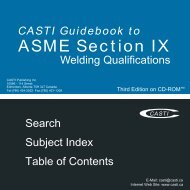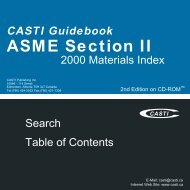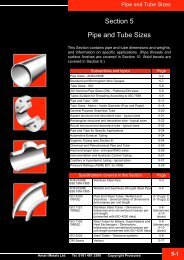Welded Steel Tanks for Oil Storage
Welded Steel Tanks for Oil Storage
Welded Steel Tanks for Oil Storage
- No tags were found...
You also want an ePaper? Increase the reach of your titles
YUMPU automatically turns print PDFs into web optimized ePapers that Google loves.
WELDED STEEL TANKS FOR OIL STORAGE 2-3<br />
98<br />
98<br />
98<br />
98<br />
k. ASTM A 737M/A 737, Grade B, <strong>for</strong> plates to a maximum<br />
thickness of 40 mm (1.5 in.).<br />
l. ASTM A 841M/A 841 <strong>for</strong> plates to a maximum thickness<br />
of 40 mm (1.5 in.) [insert plates to a maximum thickness of<br />
65 mm (2.5 in.)].<br />
2.2.3 CSA Specifications<br />
Plate furnished to CSA G40.21-M in Grades 260W, 300W,<br />
and 350W is acceptable within the limitations stated below.<br />
(If impact tests are required, Grades 260W, 300W, and 350W<br />
are designated as Grades 260WT, 300WT, and 350WT,<br />
respectively.) Imperial unit equivalent grades of CSA Specification<br />
G40.21 are also acceptable.<br />
a. The W grades may be semikilled or fully killed.<br />
b. Fully killed steel made to fine-grain practice must be specified<br />
when required.<br />
c. Elements added <strong>for</strong> grain refining or strengthening shall be<br />
restricted in accordance with Table 2-1.<br />
d. Plates shall have tensile strengths that are not more than<br />
140 MPa (20 ksi) above the minimum specified <strong>for</strong> the grade.<br />
e. Grades 260W and 300W are acceptable <strong>for</strong> plate to a maximum<br />
thickness of 25 mm (1 in.) if semikilled and to a<br />
maximum thickness of 40 mm (1.5 in.) if fully killed and<br />
made to fine-grain practice.<br />
f. Grade 350W is acceptable <strong>for</strong> plate to a maximum thickness<br />
of 45 mm (1.75 in.) [insert plates to a maximum<br />
thickness of 50 mm (2 in.)] if fully killed and made to finegrain<br />
practice.<br />
2.2.4 ISO Specifications<br />
Plate furnished to ISO 630 in Grades E 275 and E 355 is<br />
acceptable within the following limitations:<br />
a. Grade E 275 in Qualities C and D <strong>for</strong> plate to a maximum<br />
thickness of 40 mm (1.5 in.) and with a maximum manganese<br />
content of 1.5% (heat).<br />
b. Grade E 355 in Qualities C and D <strong>for</strong> plate to a maximum<br />
thickness of 45 mm (1.75 in.) [insert plates to a maximum<br />
thickness of 50 mm (2 in.)].<br />
● 2.2.5 National Standards<br />
Plates produced and tested in accordance with the requirements<br />
of a recognized national standard and within the<br />
mechanical and chemical limitations of one of the grades<br />
listed in Table 2-2 are acceptable when approved by the purchaser.<br />
The requirements of this group do not apply to the<br />
ASTM, CSA, and ISO specifications listed in 2.2.2, 2.2.3,<br />
and 2.2.4. For the purposes of this standard, a national standard<br />
is a standard that has been sanctioned by the government<br />
of the country from which the standard originates.<br />
Table 2-1—Maximum Permissible Alloy Content<br />
Alloy<br />
Heat Analysis<br />
(percent) Notes<br />
Columbium 0.05 1, 2, 3<br />
Vanadium 0.10 1, 2, 4<br />
Columbium (≤ 0.05%) plus<br />
0.10 1, 2, 3<br />
vanadium<br />
Nitrogen 0.015 1, 2, 4<br />
Copper 0.35 1, 2<br />
Nickel 0.50 1, 2<br />
Chromium 0.25 1, 2<br />
Molybdenum 0.08 1, 2<br />
● 1. When the use of these alloys or combinations of them is not 98<br />
included in the material specification, their use shall be at the option<br />
of the plate producer, subject to the approval of the purchaser. These<br />
elements shall be reported when requested by the purchaser. When<br />
more restrictive limitations are included in the material specification,<br />
those shall govern.<br />
2. On product analysis, the material shall con<strong>for</strong>m to these requirements,<br />
subject to the product analysis tolerances of the specification.<br />
3. When columbium is added either singly or in combination with<br />
vanadium, it shall be restricted to plates of 12.5 mm (0.50 in.) maximum<br />
thickness unless combined with 0.15% minimum silicon.<br />
4. When nitrogen (≤ 0.015%) is added as a supplement to vanadium,<br />
it shall be reported, and the minimum ratio of vanadium to nitrogen<br />
shall be 4:1.<br />
●<br />
2.2.6 General Requirements <strong>for</strong> Delivery<br />
2.2.6.1 The material furnished shall con<strong>for</strong>m to the<br />
applicable requirements of the listed specifications but is<br />
not restricted with respect to the location of the place of<br />
manufacture.<br />
2.2.6.2 This material is intended to be suitable <strong>for</strong> fusion<br />
welding. Welding technique is of fundamental importance,<br />
and welding procedures must provide welds whose strength<br />
and toughness are consistent with the plate material being<br />
joined. All welding per<strong>for</strong>med to repair surface defects<br />
shall be done with low-hydrogen welding electrodes compatible<br />
in chemistry, strength, and quality with the plate<br />
material.<br />
2.2.6.3 When specified by the plate purchaser, the steel<br />
shall be fully killed. When specified by the plate purchaser,<br />
fully killed steel shall be made to fine-grain practice.<br />
2.2.6.4 For plate that is to be made to specifications that<br />
limit the maximum manganese content to less than 1.60%,<br />
the limit of the manganese content may be increased to<br />
1.60% (heat) at the option of the plate producer to maintain<br />
the required strength level, provided that the maximum carbon<br />
content is reduced to 0.20% (heat) and the weldability of





